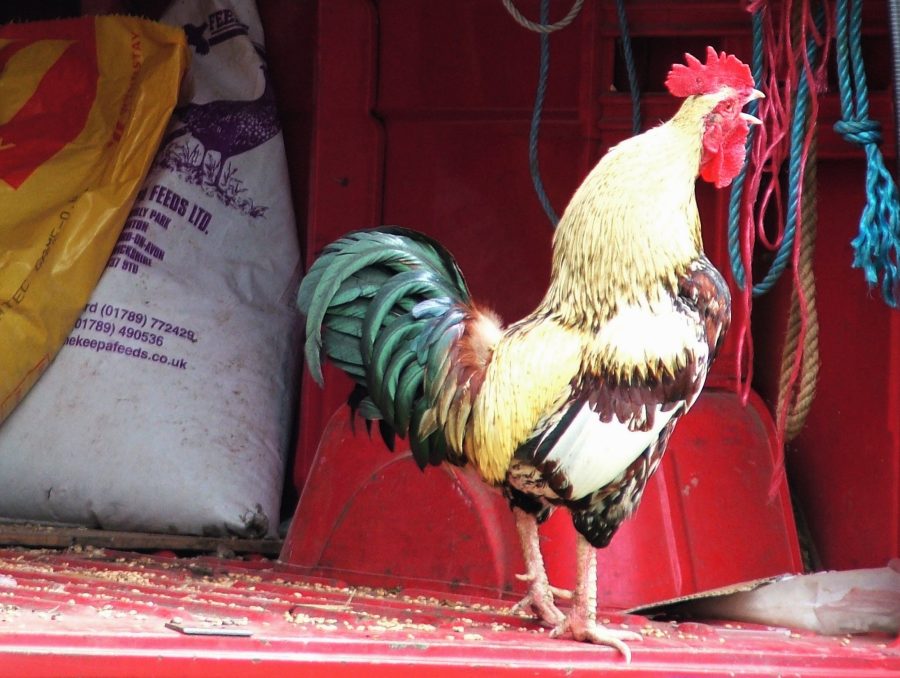According to Jeremy Hobson it seems that the male of the species – be it human or chicken – can, on occasion, cause problems!
It has been said of some small men in the past (Napoleon, for example) that what they lack in size, they make up for in tenacity. The same might be said of some bantam cockerels whose pugnacious characteristics have been used to illustrate the sometimes aggressive mannerisms of the human male. In To Kill a Mockingbird, author Harper Lee describes “a little bantam cock of a man [who] rose and strutted … the back of his neck reddening at the sound of his name.”
Of course it’s not just bantam cockerels that can be feisty; large fowl males can be too. Old English Game were originally bred for the ‘sport’ of cock-fighting’ so it’s perhaps not surprising if they have a tendency towards aggression. Sir Mark Prescott, racehorse trainer and one-time keeper of OEG, once opined that: “It’s like the difference between keeping a domestic dog and a wolf. They [OEG] don’t think the same … and they are more aggressive than other types of chickens.”
Much therefore depends on the breed. It is possible in some situations for several cocks to live happily together – at least until the breeding season when even the most mild-mannered of them is likely to turn against another male occupied in mating with what he sees to be one of ‘his’ hens.
The look of a pen of hens is undoubtedly enhanced by the presence of a cock bird and of course, if you want to breed from your stock, a male bird is an obvious necessity. However, their early morning crowing might not go down well with the neighbours. As William Shakespeare observed in Hamlet: “The cock that is the trumpet to the morn/Doth with his lofty and shrill-sounding throat/ Awake the god of day.”
OVER-SEXED AND COMPLICATED!
As lovely though the idea of breeding from one’s own stock might be, not only is a cock bird required, it’s my experience that, when hatching, you end up with more cockerels than pullets… which means you either eventually have to cull any unwanted males or find them a home – which is not always easy.
If a cock bird is kept, then it is as well to ensure that his spurs do not grow overlong as he might well damage the backs of his hens whilst trying to mate. To help prevent this, some breeders use ‘saddles’ – either commercially or home-made – affixed to the hens during the breeding season.
Some cocks can be ‘over- sexed’ and without sufficient females in the pen, their constant attentions may cause ‘scalping’ and bloody injuries to the hen’s head as they grab hold and tread the females during mating. More ladies might help alleviate the problem but it’s known that some cock birds have their ‘favourite’ hens to which they return time and time again so the addition of more females might not actually alleviate the problem.
Whether for show or simply to restock the chicken run with younger birds, those from which you breed should be healthy, typical of their type and, if for show, conform to the particular breed standard. It’s not just a question of sticking a male in with the hens and hoping for the best!
Some breeds are complicated – the Partridge Wyandotte, for instance, requires ‘cock-breeding’
pens and ‘hen-breeding’ pens depending on whether it is cocks’ or hens’ one wishes to show. Other breeds do, of course, produce show-winning stock of either sex from a single flock but, irrespective of that, unless you are fully conversant with line-breeding, it will probably be necessary to periodically introduce new bloodlines – quite often done by changing cock birds.
A cock bird when it’s not needed requires thought. In an online blog, June Molloy describes how she leant the error of her ways when adding a cock bird to her existing flock of laying hens. According to her; “The trouble started the day he arrived…”!
Photo credit: Rupert Stephenson
To receive regular copies of The Country Smallholder magazine featuring more articles like this, subscribe here.
For FREE updates from the world of smallholding, sign up for The Country Smallholder newsletter here.








